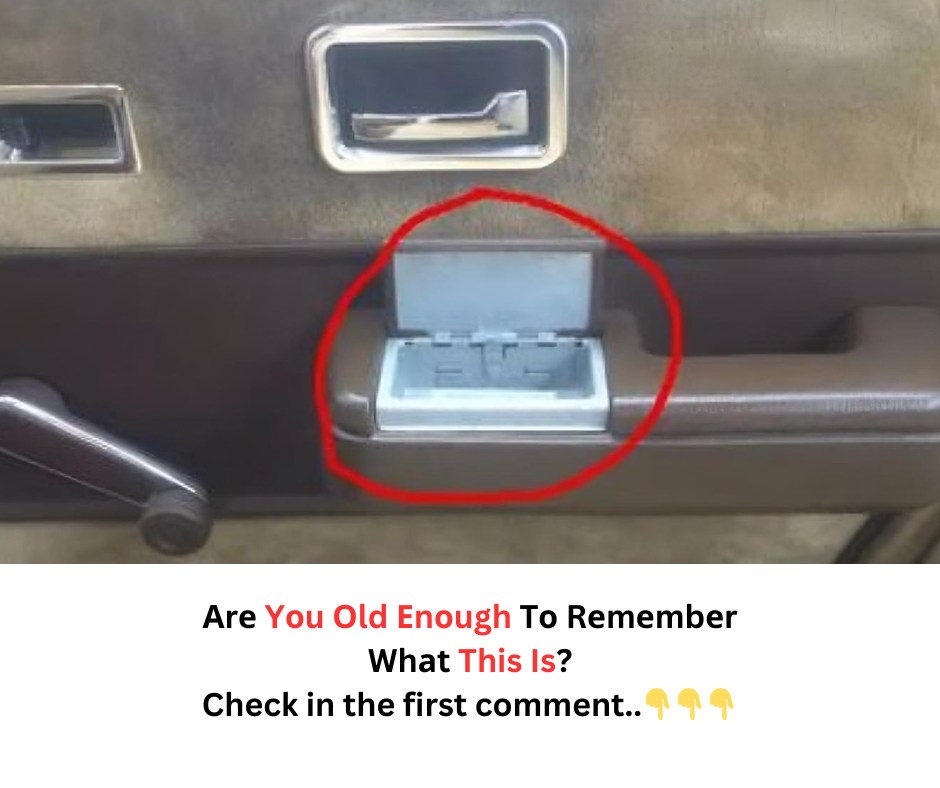If you can recall a time when every car had a built-in ashtray, you’re either getting a bit older, or you might own a classic car. Ashtrays were once a standard feature in nearly every vehicle made between the 1950s and the late 1990s. Today, they are largely a relic of the past, leaving many to wonder why they disappeared and what that says about the evolution of our driving habits.

The Rise of the Car Ashtray: A Standard Feature
In the 1950s, smoking was extremely common, and people smoked just about everywhere—including in their cars. Auto manufacturers responded by making ashtrays a standard feature in almost every vehicle. Typically located on the dashboard or the back of the front seats, these ashtrays provided a convenient way for drivers and passengers to dispose of their cigarette ashes while on the road. The ashtray became such a normal part of car design that it was taken for granted, much like the glove compartment or rearview mirror.
The ashtray, often paired with a cigarette lighter, symbolized an era when smoking was a regular part of everyday life. For decades, drivers smoked while listening to the radio, stuck in traffic, or during long road trips. The ashtray was just another accessory—no different from the seatbelt or window crank.
The Disappearance of Ashtrays in the 1990s
By the 1990s, ashtrays began to disappear from cars, catching some smokers by surprise. But what caused this once-ubiquitous feature to fade away? A combination of factors contributed to its downfall, and each one reflects significant cultural and technological changes in society.
First and foremost, there was a growing awareness of the health risks associated with smoking. The Surgeon General’s warnings, along with widespread public health campaigns, began to change attitudes toward tobacco. Fewer people were smoking, and those who did were often encouraged to quit. Car manufacturers responded to this shift by phasing out ashtrays, reflecting the changing behaviors of their customers.
At the same time, there was an increasing demand for more advanced technology and convenience features in vehicles. As car designs evolved to include electric windows, central locking, and modern infotainment systems, manufacturers needed more space in the car’s interior for these innovations. Ashtrays, once considered a necessity, became expendable. Their space was soon taken over by cup holders, charging ports, and additional storage compartments.
The Last Ashtray: Saying Goodbye to a Classic Design
In 1996, Chrysler became the last major automaker to stop including built-in ashtrays in their vehicles, marking the end of an era. The iconic flip-up ashtray, a staple of car interiors for nearly half a century, was replaced by more modern amenities.
For smokers, the removal of the ashtray posed a minor inconvenience. Some aftermarket ashtrays were made available, fitting into cup holders, but they lacked the convenience and charm of the built-in versions. A “smoker’s package” was also offered by some car manufacturers, providing a portable ashtray and lighter, but these options never fully recaptured the ease and style of the old designs.
Why Some People Miss Car Ashtrays
While the disappearance of ashtrays was a clear public health decision, some drivers still miss them. For smokers, the loss of a built-in place to dispose of cigarette ashes is an obvious inconvenience. However, even non-smokers feel a sense of nostalgia for the feature. The ashtray was more than just a functional element—it was part of a car’s personality.
Drivers often repurposed their ashtrays, using them to store loose change, gum wrappers, or small personal items. They were a convenient compartment for life’s little odds and ends. Today’s more tech-focused car interiors, though advanced and sleek, seem to lack that small but functional utility.
A Reflection of Changing Times
The removal of ashtrays from cars reflects how our driving habits have changed over the years. Smoking, once a widely accepted activity, has declined dramatically due to health campaigns and stricter regulations. The absence of ashtrays is a subtle but telling sign of how much society’s views on smoking have evolved—and how automakers have adapted to those shifts.
Moreover, the interior of today’s cars is focused on technology and convenience in ways that drivers of the 1950s could never have imagined. With GPS, Bluetooth connectivity, and infotainment systems, the modern car is designed for connectivity, not cigarette ashes. In this context, the ashtray feels like a relic from a simpler time.
The Future of Clean Cars and Sustainable Design
As we move into an era of electric vehicles and sustainable design, the absence of ashtrays takes on even greater significance. Modern cars are designed with clean energy in mind, emphasizing reduced emissions and environmental impact. Ashtrays, associated with smoking and pollution, no longer have a place in the eco-friendly vehicles of today.
Car manufacturers now focus on creating interiors with cleaner, sustainable materials, and better technology. The disappearance of the ashtray is a small part of this larger trend toward healthier, more environmentally conscious driving.
The Ashtray Fades, but the Memories Remain
While built-in ashtrays have vanished from most modern cars, they still hold a special place in the memories of those who grew up with them. The ashtray is a symbol of a different era in driving—a time when smoking was more common and cars were designed with the assumption that everyone might need a place for their cigarette ashes.
Today, with a greater emphasis on health and technology, ashtrays have become obsolete. Their absence is a reflection of how far we’ve come in our driving habits and societal norms. Even so, the memories of those flip-up ashtrays linger, offering a glimpse into how much our world—and our cars—have changed.





